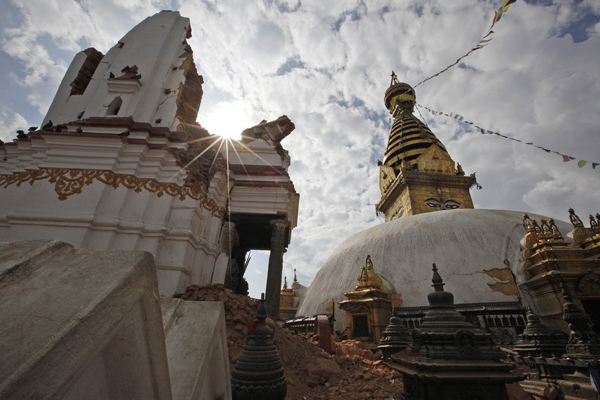 |
|
This April 30, 2015 photo shows a view of the famous Swayambhunath stupa after it was damaged in the April 25 massive earthquake in Kathmandu, Nepal. [Photo/IC] |
But since Nepal was shattered by a mammoth earthquake a week ago, those eyes have gazed upon a nation in mourning and on a microcosm of its despair inside the ancient temple itself.
At least 7,040 persons were confirmed dead with the number of injured exceeding 14,000 in the last Saturday's devastating quake in Nepal, according to the country's Ministry of Home Affairs Saturday.
The ministry said those among the killed included nine Nepalese Army personnel, four Nepalese Police personnel, one Armed Police Force staffer, four civil servants and 54 foreigners.
Swayambhunath, which dates back to the 5th century, is one of at least 68 cultural heritage sites in Nepal that were damaged by the tremor, according to Nipuna Shrestha of the UNESCO, the UN cultural heritage organization, citing preliminary figures from the Department of Archaeology. That's nearly 80 percent of historic landmarks in seven monument zones that have been declared World Heritage Sites in the Kathmandu Valley alone.
Few would compare the loss of Nepal's historic treasures to the massive human misery wrought by the magnitude-7.8 quake, which claimed more than 7,000 lives, damaged more than a million homes and displaced nearly 3 million people.
And yet, "it's hard to describe how painful this is," Shrestha said. "These are not just monuments, they are part of our daily life. It feels like losing part of your family."
Shrestha said at least 18 other monuments are known to have been damaged elsewhere, but information has been incomplete because phone networks have been disrupted and roads severed by avalanches. The sites most heavily affected were made of brick and wood.
Terrifying footage posted on YouTube of the moment the quake hit one temple complex in Bhaktapur, just east of the capital, shows chunks falling from the top of a crumbling temple as it is enshrouded in a cloud of brown dust. Tourists can be heard screaming as some struggle to stand and others try to run as buildings disintegrate around them.
Speaking earlier this past week, Prime Minister Sushil Koirala said the government's first priority was relief and rescue for all those affected. But he also vowed to rebuild "all structures of historical, religious and archaeological significance."
In an impoverished country already struggling to help the living, though, it is unclear when that will happen, or how.
Among the landmarks destroyed in the capital was the iconic, nine-story Dharahara Tower, which was topped by a statue of Shiva _ the god of destruction in Hinduism, the predominant religion among Nepal's 28 million people. The second-biggest religion is Buddhism.
Police say at least 60 bodies were recovered, most of whom were inside the tower's 213-step spiral staircase at the time. Built in 1832, Dharahara was partially destroyed during a 1934 quake, and like many sites that were toppled across the country, eventually rebuilt.